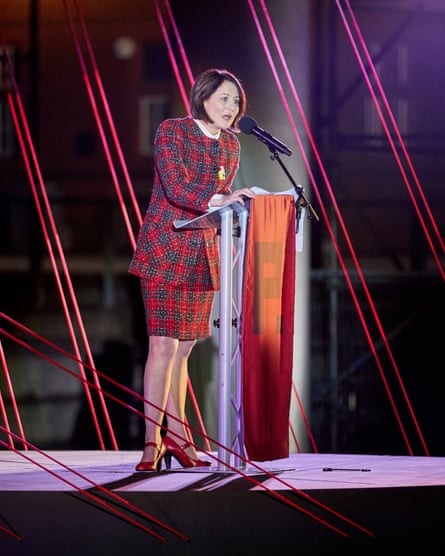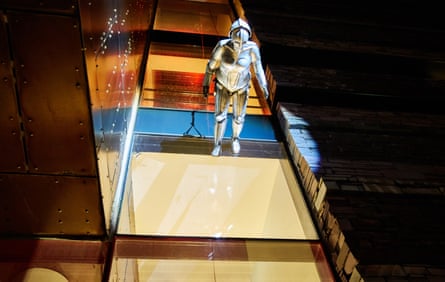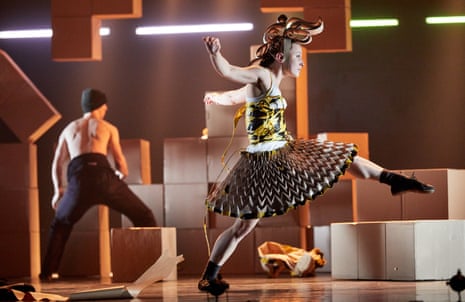Many of the ballets that Serge Diaghilev commissioned between 1909 and 1927 have been lost, and many of the surviving ones are creakily showing their age. Yet the legend of Les Ballets Russes as one of the creative powerhouse of history has persisted – in part because of the multitude of choreographers who have reinvented and reimagined individual works from its repertory.
Some have been drawn to the music (most popularly Stravinsky’s 1913 score for Rite of Spring); some to librettos (Firebird and Petrushka); and some to the visual iconography, the jazz age imagery of Le Train Bleu or the perfumed poetry of Le Spectre de la Rose. But for National Dance Company Wales (NDCW), it is Diaghilev’s relation to the Russian revolution that has provided the starting point of its show P.A.R.A.D.E. Part of a season of cultural events marking the revolution’s centenary, the company has revisited one of Diaghilev’s own most consciously radical experiments, created in 1917.

Parade was advertised as the world’s first cubist ballet – mostly in deference to Picasso’s designs, but also as a way of explaining the comic, disconnected logic of its fairground scenario and the clash of musical styles and found noise (pistol shots, sirens) in Satie’s score. The premiere of Parade in May 1917 predated the revolution by several months, but Diaghilev was an enthusiastic supporter of its early manifesto, signalling his support for the new order by having a red flag unfurled over the final scene of The Firebird when it was performed that autumn in Paris.
Later, he would be appalled by the violence done to his native country (Soviet Russia would also write him out of its history books), and it is part of the power of NDCW’s P.A.R.A.D.E that, while it is sparkily inspired by the imagery and spirit of 1917, it also confronts the destructive forces that can be unleashed by drastic change.
The performance opens with an outdoor event, directed by Marc Rees, in which we’re asked to imagine the Millennium Centre in Cardiff as a factory and to cast ourselves as workers waving flags in support of the female politician (Eiry Thomas), who appears on a podium to deliver a rousing tribute to the historic links between Russia and Wales. Rapidly, however, the sentimentality of her tribute turns into a cynical call for the assembled crowd to “embrace the new dawn of the robot revolution” – a revolution that will put the majority of the workforce out of a job.
Oratory turns into spectacle as a silver robot (aerial dancer Kate Lawrence) appears high on the roof of the Millennium Centre and, with menacing ease, starts walking down the wall. On cue, a cast of dancers in overalls, planted in the crowd, start to object, heckling the politician and uniting in an ensemble protest dance, whose chugging work rhythms and patterns recall the constructivist art of the early Bolshevik period.

It’s a wildly competing clash of energies, driven by the rich clamour of Jack White’s music. And it is on this high that we are shepherded into the auditorium for Caroline Finn’s version of the ballet Parade, which continues the factory theme, using a set design composed of a wall of cardboard boxes, with dancers dressed in same worker overalls.
Initially, the choreography is a tad routine, the dancers shunting around the boxes in slightly predictable geometric configurations. But the imaginative craziness of the original Parade gradually seeps into the work as, with the help of costume designer Rhiannon Matthews, the workers start to morph into fairground characters and a fabulous menagerie of creatures. There’s a tweeting, darting bird, its head feathers composed of a tangle of masking tape, a loping elephant, a headless woman, two dancing legs encased in a box; a clockwork ballerina in a cardboard tutu, a strutting horse with a paper mane and tail. They add up to a joyous, festive anarchy, coloured by Satie’s fairground score. Yet in its closing scene, we’re flipped back to the dystopian darkness of Rees’s vision as the silver robot reappears on stage, a sinister figure whose jerky computerised speech signals a new age of artificial intelligence and an end to the irrelevancies of art and play.

Rees and Finn create a strong pairing with their themed works, and it’s shame that NCDW have chosen to dilute them by padding out the programme with other material. En route from the outdoors to the auditorium, there is a dance vignette played out in the foyer, in which a trio of smartly outfitted women twirl around their shopping trolleys in robotic formation. Lee Johnston’s Stepford Wives might offer another spin on a alienated future, but its imagery is so far removed from the factory themed works that it serves largely as a distraction.
Equally, while I enjoyed Marcos Morau’s Tundra, a second staged dance that follows on from Finn’s Parade, it also feels as if it’s in the wrong programme. Morau continues the Russian theme, with a Russian score and a prelude that has all eight performers, male and female, gliding in unison through a traditional full-skirted Georgian dance. Stripping down to unitards, brilliantly coloured and patterned as Fabergé eggs, the cast then become linked in meticulously constructed and executed line dances, their eight bodies moving as one in ripples, waves, zigzags and angles. It is possible that there’s a homage to Diaghilev going on – these compositional devices were much favoured by the Ballets Russes choreographer Fokine – but it’s a subtle connection, and not strong enough to make the work sit well within the overall frame. I’d rather have left Cardiff with the wit and surprise of P.A.R.AD.E still zinging.

Comments (…)
Sign in or create your Guardian account to join the discussion